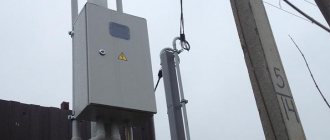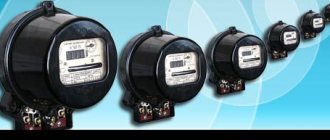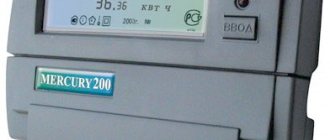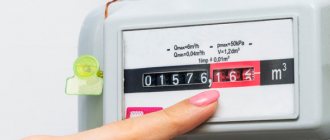Commercial electricity metering
Our company is implementing commercial electricity metering. We are engaged in projects to implement AIIS KUE in various sectors of electricity consumption in the energy market.
What is an automated electricity metering system?
The ASKUE system (automatic electricity metering control system) is equipment that is used to remotely receive, store and analyze data on electricity consumption. The main goal of this system is to accurately measure the amount of electricity consumed based on certain tariffs and specified parameters. This equipment is very useful for technical accounting as it puts data into a convenient form for analysis.
Main components of ASKUE
This automated accounting mechanism includes the following equipment:
- control and measuring instruments;
- networks for information transmission;
- computer servers;
- relevant software.
This structure allows for efficient technical accounting of electricity for any purpose. The process of operation of the ASKUE system can be divided into four levels:
- The first or lowest level includes measuring equipment that constantly measures the amount of electrical energy consumed at its metering points. The main component of this level is the electricity metering unit.
- The second level contains devices for receiving data and preparing it for further transmission. These are special measuring installations and converters with software for energy accounting. This equipment monitors energy consumption data from various meters around the clock. At the 3rd level of ASKUE there is a computer with a server on which the collection and analysis of the received information is carried out.
- The highest fourth level involves collecting data from devices located at the third level. Here their additional archiving and structuring is carried out. At this level, documentation is generated that is used for settlements on the electricity market.
Main functions of the commercial accounting system:
- High-precision measurements of supply parameters and energy consumption.
- Possibility of comprehensive technological accounting of electricity for an individual enterprise and its divisions.
- Control of electricity consumption for individual objects and energy carriers at certain time intervals.
- Informing about indicators leaving the maximum permissible range.
Our company offers installation of electricity meters based on the latest equipment. The installation is turnkey, which is very convenient for large industrial facilities. In addition, we replace electricity metering devices upon customer's request. The services offered allow us to achieve serious energy savings, which in most cases reaches 20-30%.
Main technical characteristics
For the technical characteristics of meters, the following parameters are used:
- Accuracy class — the main technical parameter that estimates the percentage of measurement error of the device. Table of accuracy classes for rated active electricity meters
Consumption category Voltage class Metering device accuracy class Citizens (individuals) Any 2.0 and higher Entries of multi-apartment residential buildings Any 1.0 and higher Consumers with power up to 670 kW Up to 35 kW inclusive 1.0 and higher Over 110 kW 0.5S and above Consumers with power over 670 kW Any 0.5S and higher with the ability to measure hourly consumption volumes and store them for more than 90 days Electricity producers Any All old household electricity meters had an accuracy class of 2.5. Today, more accurate devices with an accuracy class of 2.0 are used.
- Multiple tariffs — the ability of modern devices to keep separate records of electricity consumption by time intervals and by seasons, which is economically beneficial to consumers and makes it possible to relieve urban energy systems during peak hours.
A two-tariff system has become widespread, allowing for separate accounting of electricity consumed at certain times of the day.
- Calibration interval - a characteristic of an electric energy meter that determines the duration of the interval between verifications, which is entered in the passport and guarantees the accuracy of the readings.
Each type and model of meter has its own calibration interval. Its duration can be from four to sixteen years.
The meter parts deteriorate over time, so the accuracy of the readings decreases. Under such circumstances, the appliance becomes unusable and the utility bill becomes invalid.
The longer the interval the manufacturer promises, the longer the electric meter will last.
Date of issue (verification) of the electric meter
In my opinion, and even more so from the inspectors of the network company, this is the most important point, since if there is a dishonest seller in the store or simply out of ignorance “sells” you a single-phase electric meter for an apartment, released more than 2 years ago, then according to the accounting rules electricity - such an electric meter, the inspector will not accept it from you and will force you to check the electric meter for your apartment, house, or, which will be much faster, buy a new one. For three-phase electricity meters, the period is even shorter, and is no more than 1 year . The issue date can be seen on the electric meter panel and in the passport (form) for the electric meter in the apartment.
Single-phase electric meter Energomera CE101
Three-phase electricity meter Mercury 230 ART
Let me note one more point: when you install a previously used electric meter for an apartment somewhere (it was in an old house, garage, gifted by a friend, etc.), then for the electric meter for the apartment you must have a certificate of verification not older than 1 year for three-phase electricity meters and 2 years for single-phase ones, i.e. you can use an old electric meter for an apartment if it passes state verification before installation.
Please remember this first of all, so as not to disrupt your plans for connecting electricity; without an electric meter, no one will supply electricity to your house.
Recommendations for selection
Installing an electricity meter with a remote control on poles or without it is an individual decision. But the basic technical characteristics of the meters are the same. These include:
- power so that the building being served is uninterruptedly supplied with the required amount of electricity;
- number of phases (one corresponds to a voltage of 220 W, three - 380 W);
- tariffication (for remote ones this is one or several) at the owner’s choice.
Another equally important point for the private and summer cottage sector is the permissibility of operating equipment in the climatic conditions of a particular area. Today, according to the law, the installation of metering equipment must be carried out on neutral territory in relation to the subscriber and electricity supplier. Since buildings are often surrounded by fences, meters are fixed to the power line supports closest to the facility being served.
In turn, since the installation of an electricity meter with a remote control is carried out on a pole, you will need a box for the device. It must have a window and be spacious enough to mount the necessary set of equipment.
An example of a box (shield) for installing a meter on a pole Source en-msk.ru
In this particular case, the devices are mounted on a Din rail, so they are compact. If this were a Soviet-style induction apparatus, then a larger and insulated box would be needed. Electronic analogues cope better with climatic operating conditions, so errors in readings due to changes in temperature and humidity are reduced to a minimum. However, there are optimal temperature requirements: from 0 to +20 degrees Celsius.
How does the calculation work?
In order to carry out calculations on the wholesale volumes of the electricity market, the main requirement is the presence of a passport, in other words, a certificate of compliance of the AIIS KUE with the technical requirements of the market. The situation on the retail market is a little simpler. To organize commercial metering in the household sectors, it is enough to install a proven and technically sound electricity meter, which will be included in the state register of measuring instruments. To put the metering device into operation, you need to call an employee of the energy supply organization to receive and seal the control unit.
The collection of all commercial accounting data is carried out by network organizations, which each belong to their own network. Network organizations have the right to conduct checks to ensure compliance with all consumer conditions that were in the supply agreement. On the part of network organizations, legal owners, consumers and producers, representatives of network organizations must be provided with access to control devices that are located on the territory of the balance sheet of their electric networks. This is necessary to monitor the status of the device and read readings.
Methods for installing (mounting) an electric meter in a panel
Next, we decide how the electric meter for an apartment or house will be installed in the electrical panel, first of all - it depends on the electrical panel itself, if the design of the electrical panel allows it, then we select an electric meter for the apartment or house, which is installed on a DIN rail:
If you have an electrical panel of a different design, the electric meter for an apartment or private house can be installed on a mounting panel in the panel:
Typically, an electric meter for an apartment or private house in the first option is installed indoors, and in the second option in input distribution devices (IDUs), metering panels, etc. on the street, but it also happens in different ways, depending on the situation.
Electronic meters
For the most part, electronic meters do not contain moving mechanical parts. The exception is some types of displays, the readings of which change due to the operation of a stepper motor driving the corresponding gears of the internal gearbox [Yu.P.1].
Mechanical scoreboard:
Hybrid versions of metering devices were developed and even entered the market, containing additional functionality integrated with a conventional induction meter. We are talking about communication, storage and remote control systems. They did not take root due to the too high complexity of the work, leading to a decrease in the overall reliability of the device.
A simpler option was to manufacture the entire meter using electronic components, which include a “smart” control part in the form of a microcontroller. The latter not only performs the above functions, but also provides many additional features. For example, it calculates the total load power using incoming data on active and reactive current consumption from the corresponding sensors.
Block diagram of the internal structure of an electronic meter:
For each phase, its own combination of current and voltage transformers with sensors is used, the readings of which are sent to the input of the analog-to-digital converter microcircuit, from where they are sent to the microcontroller in the form of code sequences. In turn, it calculates the current expended, displaying the result in kilowatt-hours. The received values are sent further - to the display device and communication system (if available). The calculated information is also permanently stored in non-volatile memory. Moreover, during certain periods specified by the settings, the microcontroller places the total accumulated consumption in separate cells, which allows you to obtain a graph of load power for certain periods of time.
Also, the “smart” part of the metering device is responsible for controlling the line leading to the final client devices of the electronic electricity meter. He can, by remote or direct command, turn off consumers or perform actions in the context of power limitation conditions. That is, when the consumption on the line exceeds the established limit. This functionality is provided by a relay directly connected to the microcontroller that controls the break in the power line of client devices.
Internals of the electronic meter:
The electrical meter circuit in a simplified version, presented in the device from Texas Instruments, looks like this:
All the main elements are visible on it, including a current transformer, a digital display and the mandatory clock generator needed by all types of microcontrollers. It is the latter that sets the operating speed and reaction time of the logical part.
In essence, any existing electronic electricity meter is built on the same elements that are indicated in the given device. Of course, with the condition that different manufacturers will have a different elementary base and some components may be added that expand the final functionality.
How to choose an electric meter
It is impossible to imagine life in a perfect society without electricity.
Electricity consumption is growing every year. Absolutely all owners, be it an apartment, a private house or any non-residential premises, have a connection to multiple communications and, as a result, meters for the consumption of various resources.
Wherever there is light, an electricity meter must be installed.
This is an important device, the main task of which is to read the amount of energy consumed, namely kilowatts. Based on this, according to the meter readings, multiplied by a certain tariff, the amount payable for electricity is calculated. Every year more and more models of electric meters appear, their functionality is improved, and smart meters are appearing that can transmit information via the Internet. Their accuracy class and anti-theft means are being improved.










